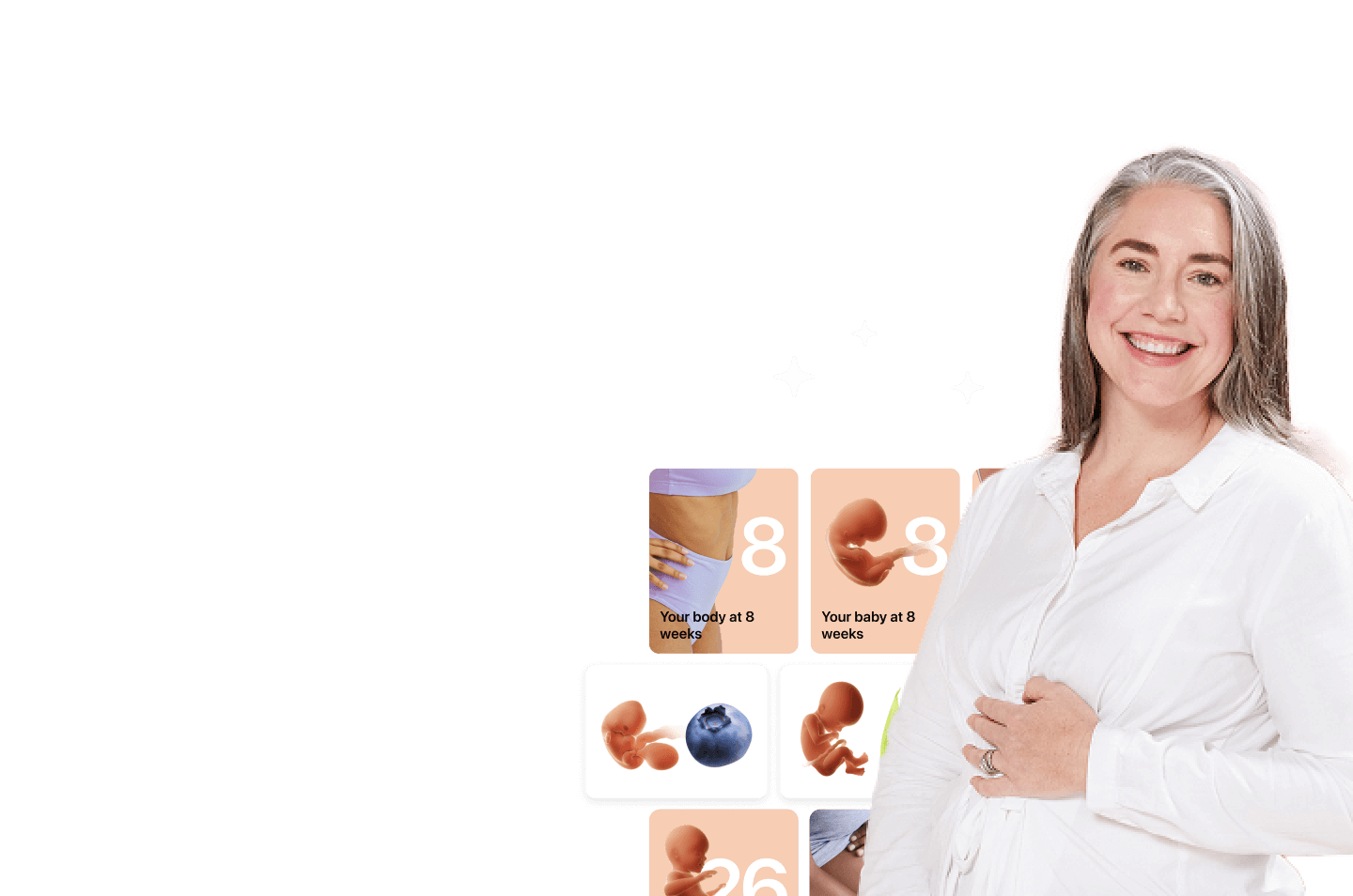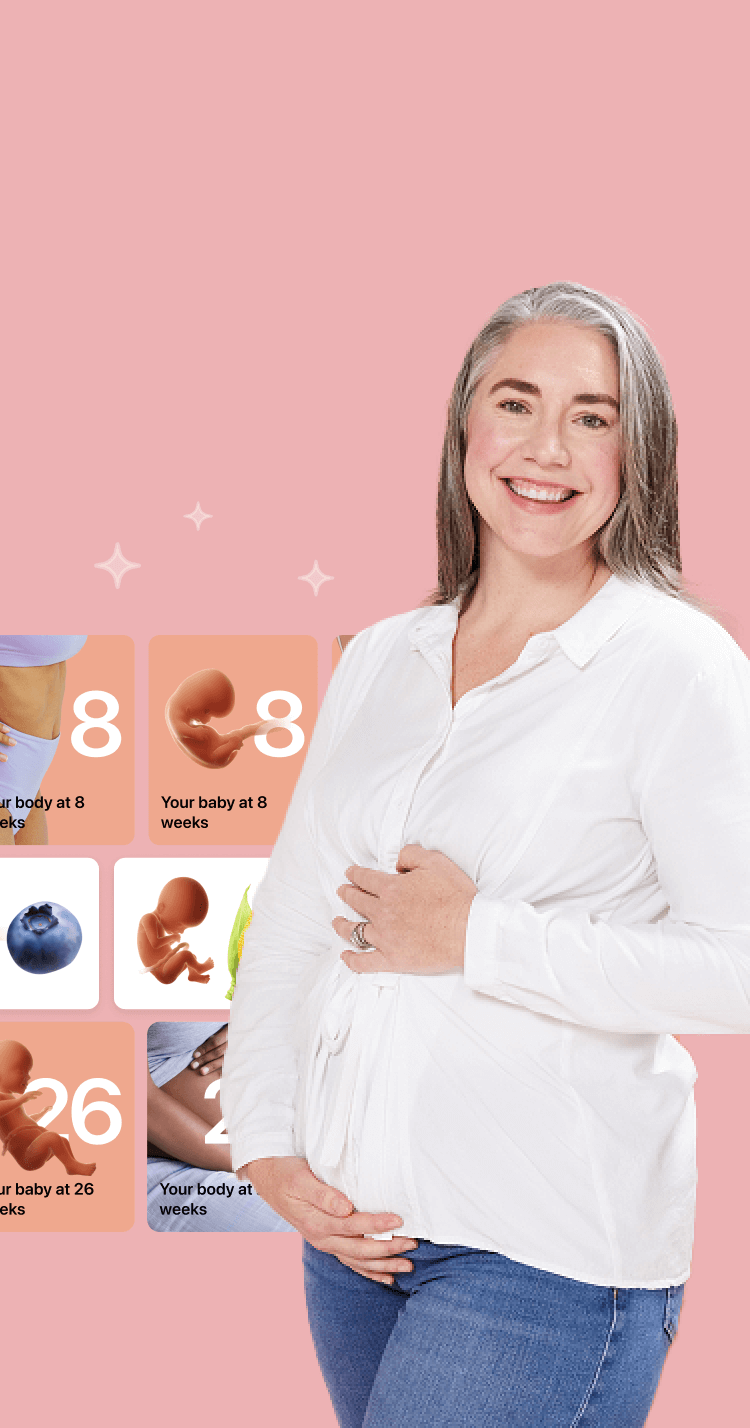It’s natural to feel on edge when you’re 9 months pregnant. Find out what to expect with advice from a Flo expert.
-
Tracking cycle
-
Getting pregnant
-
Pregnancy
-
Help Center
-
Flo for Partners
-
Anonymous Mode
-
Flo app reviews
-
Flo Premium New
-
Secret Chats New
-
Symptom Checker New
-
Your cycle
-
Health 360°
-
Getting pregnant
-
Pregnancy
-
Being a mom
-
LGBTQ+
-
Quizzes
-
Ovulation calculator
-
hCG calculator
-
Pregnancy test calculator
-
Menstrual cycle calculator
-
Period calculator
-
Implantation calculator
-
Pregnancy weeks to months calculator
-
Pregnancy due date calculator
-
IVF and FET due date calculator
-
Due date calculator by ultrasound
-
Medical Affairs
-
Science & Research
-
Pass It On Project New
-
Privacy Portal
-
Press Center
-
Flo Accuracy
-
Careers
-
Contact Us
9 months pregnant: Development and what to expect


Every piece of content at Flo Health adheres to the highest editorial standards for language, style, and medical accuracy. To learn what we do to deliver the best health and lifestyle insights to you, check out our content review principles.
At 9 months pregnant, giving birth is probably very much on your mind. It may be hard to think about much else as you count down those final weeks on your pregnancy-tracking app. You may be monitoring your body for signs that labor is near and feel a sense of anticipation. Equally, you may feel ready not to be carrying around your pregnancy belly anymore and to hold your baby. All these feelings and more are totally natural.
If your mind has been preoccupied with what birth might look like for you, it can help to focus on the fact that very soon, you’re finally going to meet your baby. So what are they up to inside your 9-months-pregnant belly? Keep reading to find out, with advice from Flo expert Dr. Renita White, obstetrician and gynecologist, Georgia Obstetrics and Gynecology, Georgia, US.
Key takeaways
- At 9 months pregnant, you’re at the end of the 3rd trimester, and your baby is finishing doing all the growing and developing that they’ll do while they’re still inside your uterus.
- You will likely be trying to spot the signs of labor this month, like feeling the baby drop, losing your mucus plug, and your water breaking. This can be exciting, frustrating, and nerve-racking all at once.
- Many babies are born a few days either side of their due date, which falls at 40 weeks pregnant. Your doctor may suggest trying to induce labor if you’re still pregnant by 42 weeks. This might sound scary, but remember, your doctor is there to answer all of your birth questions.
Take a quiz
Find out what you can do with our Health Assistant
Fetal development between weeks 36 and 40 of pregnancy
The 9th month of pregnancy is about putting the finishing touches on your baby’s growth and development. “During this last month of pregnancy, the baby continues to gain fat,” says Dr. White. “The lungs are almost ready to breathe in the outside world, and the lanugo [soft, fine hair that helps to protect your baby in the uterus] is beginning to disappear.”

Week 36
When you’re 36 weeks pregnant, your baby’s lungs are structurally mature. They’re now very good at producing surfactant, which, you may remember, is the substance that prevents the air sacs from collapsing and sticking together as they deflate.
As well as getting ready to breathe, your baby is now primed to taste things. Their taste buds are well developed by now, and they are already trying different flavors via the amniotic fluid. Research suggests that eating a varied diet can help prevent your baby from being a fussy eater after birth.
Your baby’s appearance is changing this week too: They might be losing their lanugo and will also now might have hair on their head.
Week 37
This week marks an exciting milestone. When you’re 37 weeks pregnant, your baby has reached early term. They won’t reach full term until you’re 39 weeks pregnant, though, and their lungs, liver, and brain will continue to develop over the next two weeks. However, it could still be perfectly safe for your baby to be born now.
Meanwhile, your baby’s toenails may grow to the ends of their toes this week, and their digestive system is now one step closer to forming poop. It now contains a sticky, green substance called meconium, which they should pass within 24 to 48 hours of being born. There’s still a lot going on inside your pregnant belly.
Week 38
Your baby may have lost all their lanugo by the time you’re 38 weeks pregnant, although some have small patches left for a few weeks after they are born. Currently the size of a melon, your baby is also busy gaining weight — around 0.5 lb (227 g) a week to be exact.
Week 39
When you’re 39 weeks pregnant, your baby has officially reached full term. They are now ready to be born. By now, their skin is no longer translucent and, thanks to all that weight gain, has lost most of its wrinkles too.
Interestingly, the most common week to give birth in the United States has shifted from 40 weeks in 1990 to 39 weeks in 2020. So, there’s a good chance this could be the week your baby decides to make an entrance.
Week 40
Being 40 weeks pregnant means it’s your official due date! Your baby’s organs and systems are fully developed and maturing inside you. Your little one is now the size of a watermelon and so will have less room to give you those dramatic punches and kicks. Instead, you’ll feel them doing lots of stretches, rolls, and wiggles.
It’s worth emphasizing that few babies are born on their due date. Most arrive a few days on either side. And if your baby doesn’t arrive this week, know that being born after 40 weeks is common and typically nothing to worry about.
Having said that, going overdue can be incredibly challenging for a parent-to-be. So, if you’re already 41 weeks pregnant and wondering what’s going on, hang in there! Your doctor will monitor things closely, and they can try giving your baby a nudge by sweeping the membranes of the amniotic sac. To do this, they’d need to insert their finger inside your vagina to try to separate the sac from your cervix. This can speed up labor and encourage your body to produce the hormones that make your cervix dilate. It should be very quick and only mildly uncomfortable or painful.
Alternatively, your doctor will usually suggest inducing a pregnancy with medication by 42 weeks pregnant at the latest. This is because there are some risks to letting a pregnancy go on for longer than this. For example, if your baby is born larger than average, it could lead to a more difficult delivery.
However, importantly, you can also just wait and see what happens. Whether or not to induce is your choice. Whatever you decide is right for you, know that one way or another, your baby will be here very soon.
Signs and symptoms you might experience when 9 months pregnant
“False labor contractions may be occurring this month,” says Dr. White. You may experience mild tightenings of your uterus before actual labor starts. These are Braxton Hicks contractions. Of course, by now, you may also experience the first signs of actual labor. “You may pass your mucus plug, and the baby may drop deeper into the pelvis,” she says.
Let’s take a look at the signs of labor in more detail:
- Changes to your cervix: Your cervix is the lower part of your uterus, and to prepare for delivery, it needs to become thinner and open (or dilate).
- Passing the mucus plug: While you’re pregnant, a thick plug of mucus blocks the opening of your cervix to protect your uterus from bacteria. You may notice your body passing the mucus plug before labor begins. This can look like an increase in discharge, which can be clear, pink, or slightly bloody.
- Feeling the baby drop: The process of your baby settling head-down deep into the pelvis is sometimes called lightening or engagement. It can happen anywhere from a few weeks to a few hours before labor starts and may change the shape of your belly.
- Water breaking: At the beginning of or during labor, the amniotic sac that’s been cushioning your baby ruptures. It can feel like a small trickle or a gush. If this happens, get in touch with your doctor right away.
- Contractions: True labor contractions will be stronger, more regular, and won’t stop and start. Check out our guide on how to tell the difference between Braxton Hicks and real contractions.
Being on high alert for signs of labor can have a big impact on you emotionally. There’s a lot of uncertainty to navigate, and this can be tough. Make sure you get lots of love and support this month. “It is common to feel excited and happy while also nervous and anxious as you approach your due date,” says Dr. White. “This is often because the exact date of when you will go into labor is unknown.”
Meanwhile, the 3rd-trimester pregnancy symptoms you experienced in previous months may continue through month 9, such as:
Swelling
Fluid retention can increase around now, which, along with the weight gain, can cause your ankles and feet to swell. This can be pretty uncomfortable, but it isn’t uncommon. However, if swelling is severe or sudden, contact your doctor immediately. It could be a sign of a condition like preeclampsia.
Back pain
Your baby’s growth can, unfortunately, cause backaches during the 3rd trimester as your body adjusts to carrying the extra weight.
Shortness of breath
It can be harder to take deep breaths in the 3rd trimester as your lungs don’t have enough room to expand. However, you should contact a doctor right away if the shortness of breath is sudden or severe, or comes with chest pain, heart palpitations, dizziness, or vaginal bleeding.
Peeing more
Your baby can press against your bladder as they move further into your pelvis, making you feel like you need to pee more.
Insomnia
Unfortunately, it’s common for sleep to suffer in the 3rd trimester, thanks to needing to pee more during the night and the challenge of finding a comfy position with a big belly. Check out our guide on how to sleep when you’re pregnant for 3rd-trimester insomnia tips.
Fatigue
Due to sleep troubles and the extra weight you’re carrying, it’s common to feel more tired in the 3rd trimester. However, fatigue can also be a sign that your iron levels are low, so it’s worth speaking to your doctor about doing a blood test to check this out.

Nesting
Many people experience bursts of nesting energy — one of the more enjoyable symptoms you may experience in the 9th month of pregnancy.
Hemorrhoids
Unfortunately, hemorrhoids are common in pregnancy, caused by increased pressure on the veins in your anus, increased blood volume, and greater chances of constipation.
Varicose veins
These lumpy-looking veins are caused by the increased hormones and pressure of the baby on your blood vessels.
Leg cramps
These can often strike at night as your pregnancy progresses.
Heartburn
Pregnancy hormones can relax the valve between your stomach and esophagus, causing stomach acid to leak through and result in heartburn during pregnancy.
Constipation: The increase in hormones can slow down your digestive system and lead to constipation.
Taking care of yourself during the final phase of pregnancy and postpartum
This month, you’ve made it to the end of your pregnancy. The moment of meeting your baby is just around the corner. As we’ve seen, there’s still lots of growth happening inside your belly, so it’s important to continue to get plenty of rest.
“You can also be preparing for labor and delivery,” says Dr. White. “This can include thinking about your birth plan, practicing pain management techniques, and packing your hospital bag.” It can help to learn about the different stages of labor, too.
Don’t forget, Flo’s pregnancy tracker app can help you monitor the changes happening to your baby and body week by week. You can also use the app to connect with other parents-to-be in our anonymous forum, Secret Chats.
But maybe you’re done thinking about pregnancy and are more concerned with what’s on the other side. Our health library has plenty of information on being a new parent, from safe co-sleeping positions to nipple shield advice. Check it out — and best of luck.
More frequently asked questions about being 9 months pregnant
How many weeks is 9 months pregnant?
The 40 weeks of pregnancy don’t fit neatly into nine months, but 9 months pregnant is roughly 36 to 40 weeks.
How big is a 9-months-pregnant belly?
“The belly size will differ for everyone,” says Dr. White. “It’s important not to compare because it truly does depend on your body shape. Just as the same pair of jeans fits differently on two women, it’s common that two women at the same stage of pregnancy may be showing differently.”
What are some do’s and don’ts during the 9th month of pregnancy?
“For most normal pregnancies, you can continue to exercise, work, and have sex until the day you go into labor,” says Dr. White. “However, it would not be safe to travel since you can go into labor at any point.”


Hey, I'm Anique
I started using Flo app to track my period and ovulation because we wanted to have a baby.


The Flo app helped me learn about my body and spot ovulation signs during our conception journey.


I vividly
remember the day
that we switched
Flo into
Pregnancy Mode — it was
such a special
moment.
Real stories, real results
Learn how the Flo app became an amazing cheerleader for us on our conception journey.
References
“1st Trimester Pregnancy: What to Expect.” Mayo Clinic, 27 Feb. 2024, www.mayoclinic.org/healthy-lifestyle/pregnancy-week-by-week/in-depth/pregnancy/art-20047208.
“2nd Trimester Pregnancy: What to Expect.” Mayo Clinic, 7 Feb. 2025, www.mayoclinic.org/healthy-lifestyle/pregnancy-week-by-week/in-depth/pregnancy/art-20047732.
“3rd Trimester Pregnancy: What to Expect.” Mayo Clinic, 7 Feb. 2025, www.mayoclinic.org/healthy-lifestyle/pregnancy-week-by-week/in-depth/pregnancy/art-20046767.
“Is It Safe to Fly during Pregnancy?” Mayo Clinic, 29 Dec. 2022, www.mayoclinic.org/healthy-lifestyle/pregnancy-week-by-week/expert-answers/air-travel-during-pregnancy/faq-20058087.
Colin, Andrew A., et al. “Respiratory Morbidity and Lung Function in Preterm Infants of 32 to 36 Weeks’ Gestational Age.” Pediatrics, vol. 126, no. 1, July 2010, pp. 115–28, https://doi.org/10.1542/peds.2009-1381.
Declercq, Eugene, et al. “The Natural Pattern of Birth Timing and Gestational Age in the U.S. Compared to England, and the Netherlands.” PLOS ONE, vol. 18, no. 1, Jan. 2023, https://doi.org/10.1371/journal.pone.0278856.
“Definition of Term Pregnancy.” The American College of Obstetricians and Gynecologists, Nov. 2013, www.acog.org/clinical/clinical-guidance/committee-opinion/articles/2013/11/definition-of-term-pregnancy.
“Exercise in Pregnancy.” NHS, www.nhs.uk/pregnancy/keeping-well/exercise/. Accessed 13 Mar. 2025.
“Fetal Development.” Cleveland Clinic, my.clevelandclinic.org/health/articles/7247-fetal-development-stages-of-growth. Accessed 12 Mar. 2025.
“Fetal Development: The 3rd Trimester.” Mayo Clinic, 3 June 2022, www.mayoclinic.org/healthy-lifestyle/pregnancy-week-by-week/in-depth/fetal-development/art-20045997.
“Hemorrhoids during Pregnancy.” Cleveland Clinic, my.clevelandclinic.org/health/diseases/23498-pregnancy-hemorrhoids. Accessed 12 Mar. 2025.
“Inducing Labor: When to Wait, When to Induce.” Mayo Clinic, 12 Mar. 2024, www.mayoclinic.org/healthy-lifestyle/labor-and-delivery/in-depth/inducing-labor/art-20047557.
“Lanugo.” Cleveland Clinic, my.clevelandclinic.org/health/body/22487-lanugo. Accessed 12 Mar. 2025.
“Meconium.” Cleveland Clinic, my.clevelandclinic.org/health/body/24102-meconium. Accessed 12 Mar. 2025.
“Membrane Sweep.” Cleveland Clinic, my.clevelandclinic.org/health/treatments/21900-membrane-sweep. Accessed 12 Mar. 2025.
“Newborn Respiratory Distress Syndrome.” NHS, www.nhs.uk/conditions/neonatal-respiratory-distress-syndrome/. Accessed 12 Mar. 2025.
“Overdue Pregnancy: What to Do When Baby’s Overdue.” Mayo Clinic, 11 Mar. 2025, www.mayoclinic.org/healthy-lifestyle/pregnancy-week-by-week/in-depth/overdue-pregnancy/art-20048287.
“Meconium.” ScienceDirect. www.sciencedirect.com/topics/immunology-and-microbiology/meconium. Accessed 12 Mar. 2025.
“Sex in Pregnancy.” NHS, www.nhs.uk/pregnancy/keeping-well/sex/. Accessed 13 Mar. 2025.
“Signs of Labor: Know What to Expect.” Mayo Clinic, 23 July 2024, www.mayoclinic.org/healthy-lifestyle/labor-and-delivery/in-depth/signs-of-labor/art-20046184.
“Staying Comfortable in the Third Trimester.” Northwestern Medicine, May 2022, www.nm.org/healthbeat/healthy-tips/staying-comfortable-in-the-third-trimester.
Bunce, Emily E., and Robert P. Heine. “Swelling during Late Pregnancy.” MSD Manual Consumer Version, July 2023, www.msdmanuals.com/home/women-s-health-issues/symptoms-during-pregnancy/swelling-during-late-pregnancy.
“Third Trimester.” Cleveland Clinic, my.clevelandclinic.org/health/articles/third-trimester. Accessed 12 Mar. 2025.
Ustun, Beyza, et al. “Flavor Sensing in Utero and Emerging Discriminative Behaviors in the Human Fetus.” Psychological Science, vol. 33, no. 10, Oct. 2022, pp. 1651–63, https://doi.org/10.1177/09567976221105460.
“Varicose Veins While Pregnant.” Cleveland Clinic, my.clevelandclinic.org/health/diseases/23331-varicose-veins-in-pregnancy. Accessed 12 Mar. 2025.
“You and Your Baby at 37 Weeks Pregnant.” NHS, www.nhs.uk/pregnancy/week-by-week/28-to-40-plus/37-weeks/. Accessed 13 Mar. 2025.




